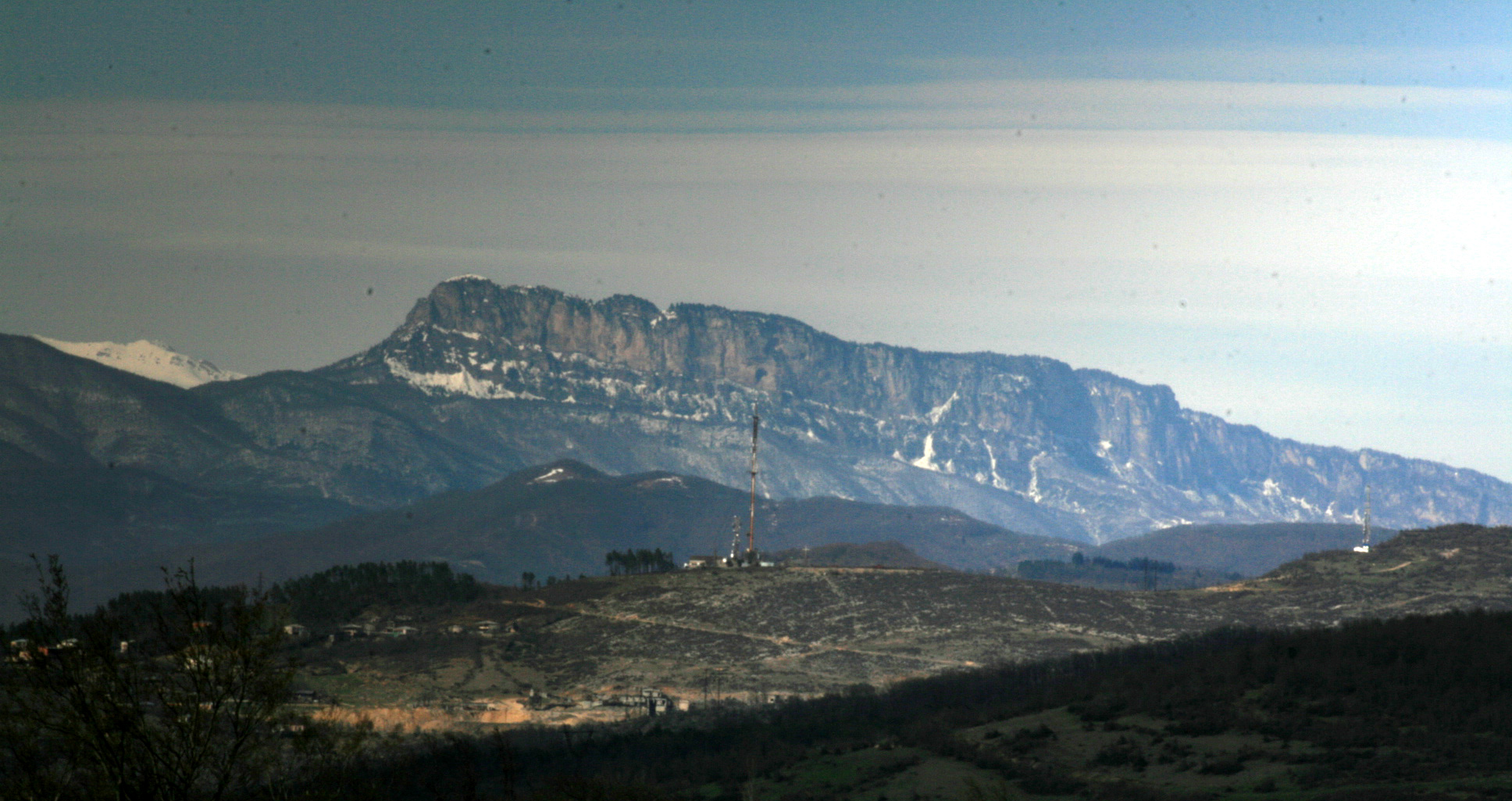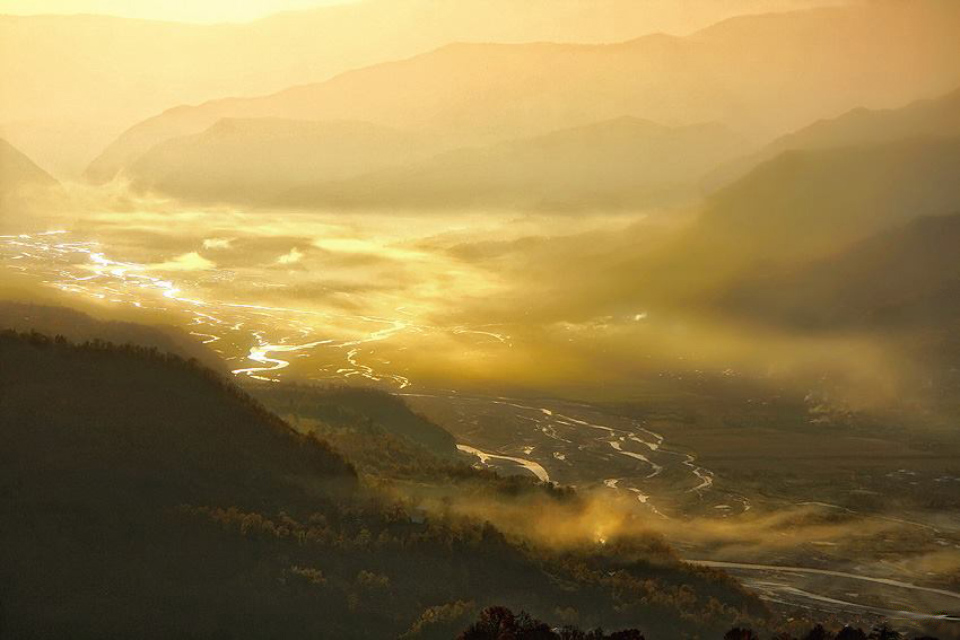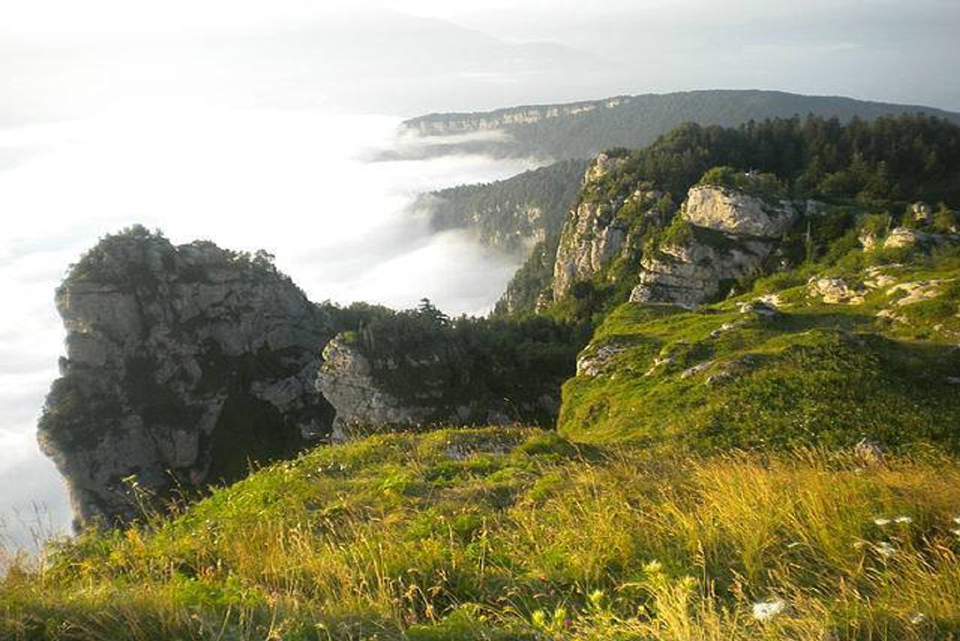
This tour is specially made for young people who would like to meet the sunrise together and save in memory majestic beauty of Georgian nature!
There is an interesting folk tale - When the Lord was moving to the heaven, in his hands he was carrying jewels and precious stones. Near the Caucasian ridge he stumbled and scattered all his jewels around the mountain. As the saying is, it is better to see something once than hear about it hundred times. The same is with this beautiful mountain and its legends. In good weather, standing on Khvamli mountain, you will see the Black Sea. It seems that the sea is just a few hundred meters away. A lot of legends have been created about Khvamli mountain. Another legend is that there are treasures hidden in the mountain enough to feed the whole Georgia for decades. During the Soviet Union many expeditions, classified as secret, were sent to explore the mountain, but all attempts to descend in the caves of the mysterious mountain ended in fail .
The mountain is located in Letchkhumi region. Its height is 2002 m.
Among the caves we distinguish Tekenteri and an ‘Icy Cave of God’. The mountain is coverd with thick forest. According to ancient annals, legend of Khvamli relate to the Greek characters, such as Hercules and Argonauts. It is considered to be the place where Zeus punished and bound Prometeus and then Hercules rescued him. In the 50’ of the 19th century an expedition led by a famous Italian explorer and traveler Daniella Pizagallo arrived on mount Khvamli. She was searching for places where Argonauts passed and where Prometeus was bound.
As later she wrote in her memoirs, she was astonished by the fact that all the natives knew the legends very well and they were amused by the fact that they used to hunt and kill the vultures, which, according to the legend, pecked the Prometheus’ liver. According to historical information, Khvamli mountain was depicted by a world-known author Jules Verne in his adventure novel Stubborn Keraban. Apolonius of Rodos also describes in his manuscripts Khvanli mountain as a place of Argonauts’ travel. According to scientists, in the caves of Mount Hvamli information about the Basque, Sumerians, Indians and Feregs might have been preserved, as well as information on the connections of these peoples to Georgia. The secrets of the origin of metallurgy in Georgia are also connected to Khvamli mountain. The creation of an iron tool in those times can be compared only to the explosion of a nuclear bomb in our days. The cost of iron then was similar to the today’s cost of oil.
There are many interesting places at the foot of the mountain, but the territory called Gona deserves our special attention.
Etymologically, the word gona means knowledge, education. High in the mountains of Gona, in Racha region, there were lots of mines. People used to go up narrow paths to get there where they extracted, processed metallic ore and poured it into special molds.
From this follows that, in fact, in those times the Georgians had a special tool of labor that helped them to mine ore in great numbers. In these spaces, a developed civilization in the sphere of metallurgy was created. That everything embraces the whole Colchis culture and it can provide much more information than it is for us to know.
It is interesting to know, that on the walls of the cave the scientist found some signs/symbols depicted in red. They were symbols of the cosmos: Aquarius, Capricorn, Mercury and Venus (thesame Isis and Osiris), the symbols of Mars and the Sun , and the keys in the quadrangle are the most sacred symbols of Osiris and Isis. The scientists used a special astrological program and reconstructed the picture of the star sky from the signs on the wall. According to them, the skyline was accurately reflected in the panorama of the sky typical for 5604 BC - the location of Mercury, Venus, Mars and the constellation of Sagittarius. This combination did not repeat in other years. This date - 5604 BC - coincides with the date of the last flood on the Earth.
Thereby, the results of an independent study of professors from the University of Columbia, William Pitman and Walter Ryan are interesting. In 1998, American scientists published a work on
their research on the last flood: according to them, the Mediterranean Sea broke through the rocky barrier of the Bosporus Strait, and large arrays of water poured into the Black Sea at great speed. Due to the flood, the territory was flooded with 150 thousand km2. According to modern estimates, it was 5604 BC - the beginning of the Sumerian and Georgian chronology before the birth of Christ. This fact forces scientists to think that the astronomical picture of the beginning of the new chronology is imprinted on the walls of the cave in Hvamli.
It is a short description of Khvamli and its history , of the place where you can see the most amazing nature and the most impressive dawn.
There is an interesting folk tale - When the Lord was moving to the heaven, in his hands he was carrying jewels and precious stones. Near the Caucasian ridge he stumbled and scattered all his jewels around the mountain. As the saying is, it is better to see something once than hear about it hundred times. The same is with this beautiful mountain and its legends. In good weather, standing on Khvamli mountain, you will see the Black Sea. It seems that the sea is just a few hundred meters away. A lot of legends have been created about Khvamli mountain. Another legend is that there are treasures hidden in the mountain enough to feed the whole Georgia for decades. During the Soviet Union many expeditions, classified as secret, were sent to explore the mountain, but all attempts to descend in the caves of the mysterious mountain ended in fail .
The mountain is located in Letchkhumi region. Its height is 2002 m.
Among the caves we distinguish Tekenteri and an ‘Icy Cave of God’. The mountain is coverd with thick forest. According to ancient annals, legend of Khvamli relate to the Greek characters, such as Hercules and Argonauts. It is considered to be the place where Zeus punished and bound Prometeus and then Hercules rescued him. In the 50’ of the 19th century an expedition led by a famous Italian explorer and traveler Daniella Pizagallo arrived on mount Khvamli. She was searching for places where Argonauts passed and where Prometeus was bound.
As later she wrote in her memoirs, she was astonished by the fact that all the natives knew the legends very well and they were amused by the fact that they used to hunt and kill the vultures, which, according to the legend, pecked the Prometheus’ liver. According to historical information, Khvamli mountain was depicted by a world-known author Jules Verne in his adventure novel Stubborn Keraban. Apolonius of Rodos also describes in his manuscripts Khvanli mountain as a place of Argonauts’ travel. According to scientists, in the caves of Mount Hvamli information about the Basque, Sumerians, Indians and Feregs might have been preserved, as well as information on the connections of these peoples to Georgia. The secrets of the origin of metallurgy in Georgia are also connected to Khvamli mountain. The creation of an iron tool in those times can be compared only to the explosion of a nuclear bomb in our days. The cost of iron then was similar to the today’s cost of oil.
There are many interesting places at the foot of the mountain, but the territory called Gona deserves our special attention.
Etymologically, the word gona means knowledge, education. High in the mountains of Gona, in Racha region, there were lots of mines. People used to go up narrow paths to get there where they extracted, processed metallic ore and poured it into special molds.
From this follows that, in fact, in those times the Georgians had a special tool of labor that helped them to mine ore in great numbers. In these spaces, a developed civilization in the sphere of metallurgy was created. That everything embraces the whole Colchis culture and it can provide much more information than it is for us to know.
It is interesting to know, that on the walls of the cave the scientist found some signs/symbols depicted in red. They were symbols of the cosmos: Aquarius, Capricorn, Mercury and Venus (thesame Isis and Osiris), the symbols of Mars and the Sun , and the keys in the quadrangle are the most sacred symbols of Osiris and Isis. The scientists used a special astrological program and reconstructed the picture of the star sky from the signs on the wall. According to them, the skyline was accurately reflected in the panorama of the sky typical for 5604 BC - the location of Mercury, Venus, Mars and the constellation of Sagittarius. This combination did not repeat in other years. This date - 5604 BC - coincides with the date of the last flood on the Earth.
Thereby, the results of an independent study of professors from the University of Columbia, William Pitman and Walter Ryan are interesting. In 1998, American scientists published a work on
their research on the last flood: according to them, the Mediterranean Sea broke through the rocky barrier of the Bosporus Strait, and large arrays of water poured into the Black Sea at great speed. Due to the flood, the territory was flooded with 150 thousand km2. According to modern estimates, it was 5604 BC - the beginning of the Sumerian and Georgian chronology before the birth of Christ. This fact forces scientists to think that the astronomical picture of the beginning of the new chronology is imprinted on the walls of the cave in Hvamli.
It is a short description of Khvamli and its history , of the place where you can see the most amazing nature and the most impressive dawn.







